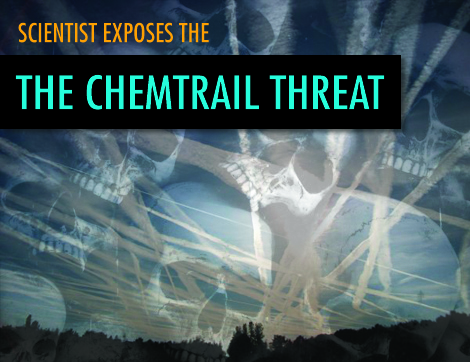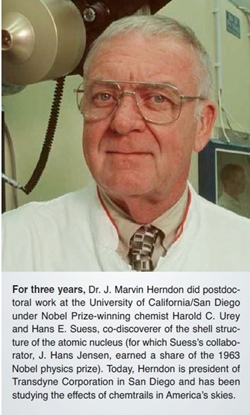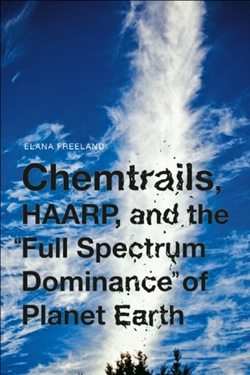
Geo-scientist Dr. J. Marvin Herndon is disputing a peer-reviewed scientific journal’s abrupt decision to retract his intriguing research article on “chemtrails.”
News of Herndon’s August 11 scientific paper being published in the International Journal of Environmental Research was reported recently in AMERICAN FREE PRESS, since that article was the first paper of its kind on this sensitive subject ever to have appeared in a peer-reviewed journal.
That journal on September 2 suddenly retracted the latest paper, in what Herndon sees as political push-back from behind the scenes, regarding the paper’s revelation of chemtrails’ existence, their apparent atmospheric contents, and their possible effects on human health.
Chemtrails are those long cloud-like streaks and sheets which somewhat resemble jet exhaust but are sprayed in a manner that produces crisscross patterns in the sky, sometimes resulting in an unnatural whitish haze.
The official retraction statement from the journal’s editorial board mainly claims that the August 11 paper’s stated aluminum value, regarding leachate concentration, was seen as “incorrect,” and that this error allegedly invalidates the conclusions of Herndon’s paper.
But Herndon says that this one error, which he admits occurred, was blown out of proportion and does not invalidate the paper’s overall conclusions. At press-time he was in the process of formally contesting the basis of the retraction. In its retraction the journal also took exception with what it saw as an unscientific tone, in terms of how Herndon’s paper was worded.
Concerning a substance known to be particularly hazardous, his paper states that coal fly ash, a byproduct of coal burning, is the most likely substance being sprayed into the atmosphere, including the lower troposphere which people breathe, as part of an apparently deliberate geo-engineering policy thought to be geared toward fighting “global warming” and weather modification.
In the spirit of free inquiry, AFP sought to report about, not suppress, Herndon’s paper when it first came out and will continue following the story. Read on below for the rest of AFP’s initial summation of the paper.
(Original article is below.—Ed.)
• Researcher reveals nations spraying hazardous chemicals in atmosphere.
By Mark Anderson
A respected peer-reviewed scientific journal has boldly published the groundbreaking research of a noted San Diego geoscientist about “chemtrails,” shedding important new light on the murky subject by identifying a particularly hazardous substance being sprayed into the atmosphere.
Dr. J. Marvin Herndon’s paper in the International Journal of Environmental Research and Public Health reveals that this substance is coal fly ash, a byproduct of coal burning.

Coal fly ash is comprised of micron and sub-micron particles that would go up the smokestack unless captured and stored. Because of its adverse environmental health effects, Western nations now require coal-combustion fly ash to be captured and stored.
Used as a Portland cement additive, for agricultural soil amendments, mine reclamation, melting river ice and as subsurface material for roads, coal fly ash also is a concentrated repository for many trace elements: arsenic, barium, beryllium, boron, cadmium, chromium, cobalt, lead, manganese, mercury, molybdenum, selenium, thallium, thorium, vanadium and uranium.
His paper, entitled “Evidence of Coal Fly Ash Toxic Chemical Geoengineering in the Troposphere: Consequences for Public Health,” should bring much-needed visibility and legitimacy to chemtrails, a subject that’s still unknown to most citizens. The paper vindicates other researchers and activists who’ve been laboring to call attention to those strange cloud-like streaks crisscrossing our skies and their potential dangers.*
“There’s nothing in the scientific literature that I’ve been able to find on this subject,” Herndon told AMERICAN FREE PRESS August 25. “As far as legitimate scientific papers, there appear to be none”—regarding what his paper calls “the intentional and increasingly frequent chemical emplacement [spraying] in the troposphere.”
Herndon, who wrote one earlier peer-reviewed paper concerning aerial spraying affecting India, stressed that his latest paper, published August 11, 2015, is based on much more thorough research representing a “quantum leap” on the subject. His research showed that the use of coal fly ash could lead to class-action lawsuits over its adverse health effects. Furthermore, secretive chemtrails operations could be fully exposed.
Geoengineering is nothing new. Cloud seeding to make rain has been around for decades. Herndon’s paper remarks: “The recent calls for open discussion of climate control or geoengineering tend to obscure the fact that the world’s military and civilian sectors have modified atmospheric conditions for many decades.”
What’s new is Herndon’s research-based evidence that “toxic coal-combustion fly ash” is the chief ingredient in aerosols “being sprayed by tanker-jets for geoengineering, weather-modification and climate-modification purposes,” his paper states.
“The consequences on public health are profound, including exposure to a variety of toxic heavy metals, radioactive elements, and neurologically implicated chemically mobile aluminum released by body moisture after inhalation or through transdermal (skin) induction,” he added.
Herndon’s methodology consisted of analyzing eight elements in rainwater, leached from aerosolized particulates. The findings were compared with the results of leaching the same elements from coal fly ash into water in a lab setting. He also looked at 14 elements in dust trapped with a high-efficiency particulate matter (HEPA) filter in an air purifier operated outdoors. The corresponding elements in un-leached coal fly-ash material were then compared with those 14 elements.
Dangers to Health
Aluminum is abundant in the Earth’s crust but is normally immobile. Herndon’s paper notes its toxicity when it becomes “mobilized” via spraying.
“It is a matter of grave concern that aluminum in a chemically mobile form can be readily extracted from coal fly ash with rainwater or [in contact with] bodily fluids,” he wrote. “Aluminum is implicated in such neurological diseases as autism spectrum disorder, Alzheimer’s disease, Parkinson’s disease and attention deficit hyperactivity disorder, all of which have markedly increased in recent years. Aluminum is thought to impair fertility in men and is also implicated in neurological disorders of bees and other creatures.”
Herndon, who’s calling for more research along these lines, told AFP he’s astounded that atmospheric spraying is being done at all, secretly no less, when no one has fully nailed down its short- and long-term health effects.
Geo-engineering researchers deceptively talk as if atmospheric chemical spraying is some futuristic scenario involving spraying in the stratosphere, or upper atmosphere, where the dispersed materials would remain suspended for long time periods and not adversely affect humans and other life forms.
“But it’s happening now, in the troposphere [lower atmosphere], which mixes with the air we breathe,” said Herndon.
He has observed firsthand that the “chemtrailed” material does not remain in the troposphere and must be frequently replenished. Moreover, ultrafine coal fly ash “is readily entrained in terminal airways and . . . retained in the lungs for long periods of time; the small grain-size enables it to . . . reach deep within the airways where it can cause inflammation and pulmonary injury.”
Softcover, 272 pages
His paper adds: “If in fact some instances of neurological diseases are related to weather-modification activities during the last two decades involving the tropospheric coal fly-ash aerosols, then the recent ramp-up in tanker-jet spraying, as witnessed by this author [Herndon] in San Diego, will likely cause a sharp spike in their occurrence. . . . Epidemiological investigations of wide-ranging scope, including for example childhood and elderly disorders and birth defects, may begin to shed light on the human toll extracted by spraying coal fly ash into the troposphere.”
Herndon added that the “near-daily intense aerial spraying over San Diego” he has witnessed appears to be part of a multinational program that has been observed for a number of years in United States, Canada, Europe, Australia and New Zealand but is “never acknowledged publicly by officials.” Given the absence of disclosure and public consent “it is difficult to know the underlying motivations and the range of specific activities involved.”
A crucial question is whether coal fly ash retards rain, possibly linking coal fly-ash spraying to droughts like the one plaguing California. Herndon’s paper, quoting a National Aeronautics and Space Administration report, notes that normal rainfall droplet formation is disrupted when “more and more pollution particles (aerosols) enter a raincloud.”
Herndon summarizes: “In addition to preventing water droplets from coalescing and growing large enough to fall to Earth, coal fly ash . . . will hydrate, trapping additional moisture, thus further acting to prevent rainfall. That may cause drought in some areas, floods in others, crop failure, forest die-offs and adverse ecological impacts.”
The grand irony is that if curbing global warming is a goal of aerial spraying, Herndon has identified reasons why the process actually could exacerbate global warming.
* The paper was retracted on 9/2/2015.
AFP Roving Editor Mark Anderson is a veteran reporter who covers the annual Bilderberg meetings and is chairman of AFP’s new America First Action Committee, designed to involve AFP readers in focusing intensely on Congress to enact key changes, including monetary reform and a pullback of the warfare state. He and his wife Angie often work together on news projects.



I am honestly amazed by some of these responses. My dad was a pilot and my ex-wifes dad has numerous jets including a Dassault Falcon 50, a Lear 9000, a Hawker Sidley and a bunch of other toys. I have discussed chemtrailing with his pilots and him and they know what is going on. Jet fuel hasn’t changed that much and certainly doesn’t spit out strands of gunk that take many hours, if not days to come down. Numerous people i know have chatted to in various state departments, including the big intelligence agency one have owned the fact that this stuff has been going on for years but has ramped up over the past 20. At some point someone is going to be accountable. The toxicity in the soil and lakes has been well documented and in the snow on Mt. Shasta. It’s always interesting to note that the main debunkers are always funded by / get grants from the same players. You know who you are. You can’t silence everyone.
There are multiple problems with these papers: figures are incorrect, values given are off by several orders of magnitude, masses are calculated incorrectly, data sets appear to have been chosen arbitrarily. But the biggest problem with the paper, even if we take the data at face value, is that there’s no actually correlation of the data sets, and no control is used. Statistical significance tests are applied incorrectly.
I shall list the major problems here, and then discuss them in more depth as needed. The two papers will be referred to as CS (Current Science, the India Paper) and IJ (International Journal, the U.S. paper) for convenience. The Moreno paper will also also be frequently referenced, and all three papers are attached to this post.
In CS, Figure 6 contains two sets of data, but one is just the mirror of the other, and not actual separate data.
In CS, the incorrect data is claimed to have a “fingerprint similarity” when the data sets are distinctly different.
In both CS and IJ, no attempt is made to tie the data to airplanes, other than the claim that the author first noticed persistent trails over his home city in 2014.
In IJ, Table 1, he lists Moreno’s value for un-leached Aluminum at 70,000 µg/kg, when the actual figure derived from Moreno’s Table 2 data is 14%, or 140,000,000 µg/kg
In both CS and IJ, the graphs are plotted with a logarithmic scale, which makes vastly dissimilar values look similar.
In IJ, the data are adjusted so the values for Aluminum are identical, and then the identical Aluminum values are include in the graph, giving a false impression of correlation.
In IJ, the reference values from Moreno show huge semi-random ranges in values, the compared values generally fall outside these ranges, and yet are described as being statistically identical.
In IJ, Figure 1 is described as photos “taken on cloudless days”, and yet clouds can clearly be seen in the images.
Here is the site if you would like to look for yourself. This site also shows a bunch of this guy’s other papers which are so crazy and wild it just makes me laugh. This guy is bonkers.
J. Marvin Herndon wrote a chapter in a ‘proceedings,’ so he must be a senior scientist in his specialty. Looks it hasn’t been retracted, either. Wonder if Herndon’s critic here, Dr. Jimby, can understand any of it?
Neutrino Geophysics: Proceedings of Neutrino Sciences 2005
pp 53-89
Solar System Processes Underlying Planetary Formation, Geodynamics, and the Georeactor
J. Marvin Herndon
Chemtrails are a horrible fact. I’d guess that Herndon gathered courage and published his article as a public service, but—predictably—the establishment is out to silence him. I hope he knows we appreciate him, and I hope they do not totally ruin his career. If he made a mistake or two, his aren’t nearly as egregious as some that are overlooked by the publishing powers that be. And a lot of good researchers make mistakes sometimes, as they all know. The scorn his critics heap on him is not deserved and only shows their rabid desire to smear his revealing work.
You can safely say that the chemtrails paper is a piece of crap. Your paper has to be spectacularly bad to be retracted from one of these low-quality journals, which says a lot about the quality of science in this chemtrails paper.
Evidence of Coal-Fly-Ash Toxic Chemical Geoengineering in the Troposphere: Consequences for Public Health
Reason why it was retracted by the publishers:
Retraction: Herndon J.M. Evidence of Coal-Fly-Ash Toxic Chemical Geoengineering in the Troposphere: Consequences for Public Health. Int. J. Environ. Res. Public Health 2015, 12, 9375–9390
Herndon based his conclusions on a value he got wrong from another paper: He used 70,000 µg/kg where the other paper said 140,000,000 µg/kg.
What are the details of the retractions? When? By whom?
This subject is never mentioned in the climate change debate and it seems that the USA and the USSR signed the atmospheric test ban treaty in haste once they learned just what kind of long term damage they may have caused. Generally broadcasting chemicals is a somewhat expensive effort, particularly when sustained over a long term, and certainly beneficial reasons would be something politicians would normally scramble to claim credit for. Might there be an attempt to repair certain damage that was done, and an ongoing effort to conceal this behind ‘climate change’?